Maine is the easternmost state in the United States and one of the least densely populated. The Pine Tree State is known primarily for its scenery which includes rocky shorelines and old-growth forests. Animals that make their homes in Maine include moose and Canadian lynx.
The state is also home to many species of spiders. In fact, there are a whopping 677 known spider species residing in Maine! Researcher Daniel Jennings of Maine made it a multi-decades project of identifying all the spiders in Maine that he could. In 1946, one researcher had already identified 154 species. By setting spider traps, searching through underbrush and foliage, and scanning the countryside of all 16 of Maine’s counties, Jennings added to that list, and it’s estimated there are more than 677 (one researcher identified 683). From house spiders to orb-weavers, you can find a plethora of spiders in Maine. Here is a list of just 10 spiders in Maine that you may encounter the next time you go walking throughout the state.
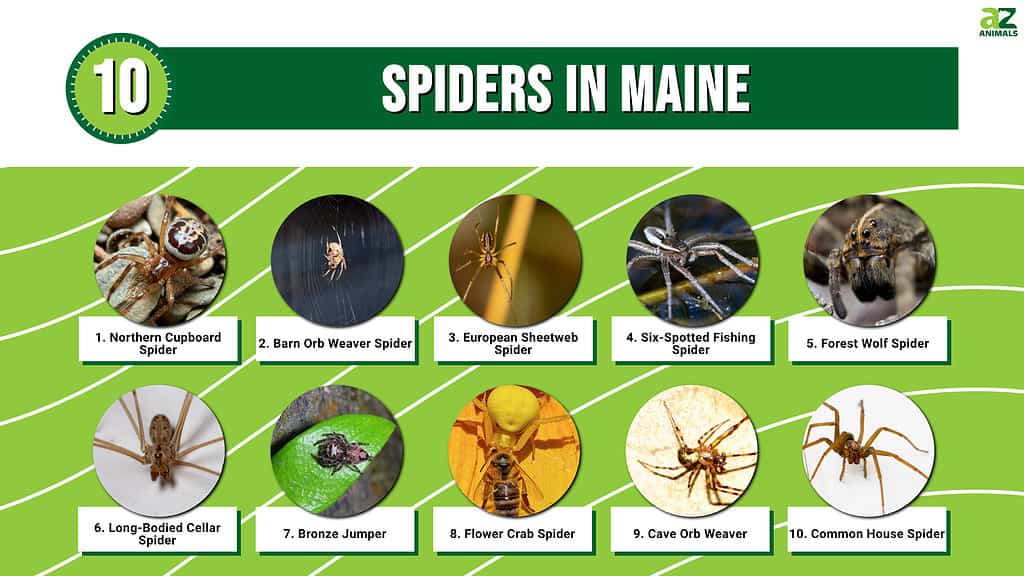
#10: Common House Spider

The common house spider also goes by the name the American house spider.
©Sample Stars/Shutterstock.com
Parasteatoda tepidariorum, or the common house spider, belongs to the cobweb spider family Theridiidae. You can find these spiders in Maine as well as throughout much of the world. It also goes by the name American house spider.
Female common house spiders measure 5 to 6 millimeters long while males measure 3.8 to 4.7 millimeters. They come in a variety of sizes and colors, which can make them difficult to identify.
Their color ranges from light tan to black, and males feature orangish-brown bands on their legs. Many people often mistake them for black widow spiders due to their similarly-shaped abdomens.
Thanks to their appearance, common house spiders can easily blend into the background into areas in homes where they like to build their webs. They build irregular cobwebs that they use to capture their prey. Due to their small size, they pose little threat to humans.
#9: Cave Orb Weaver
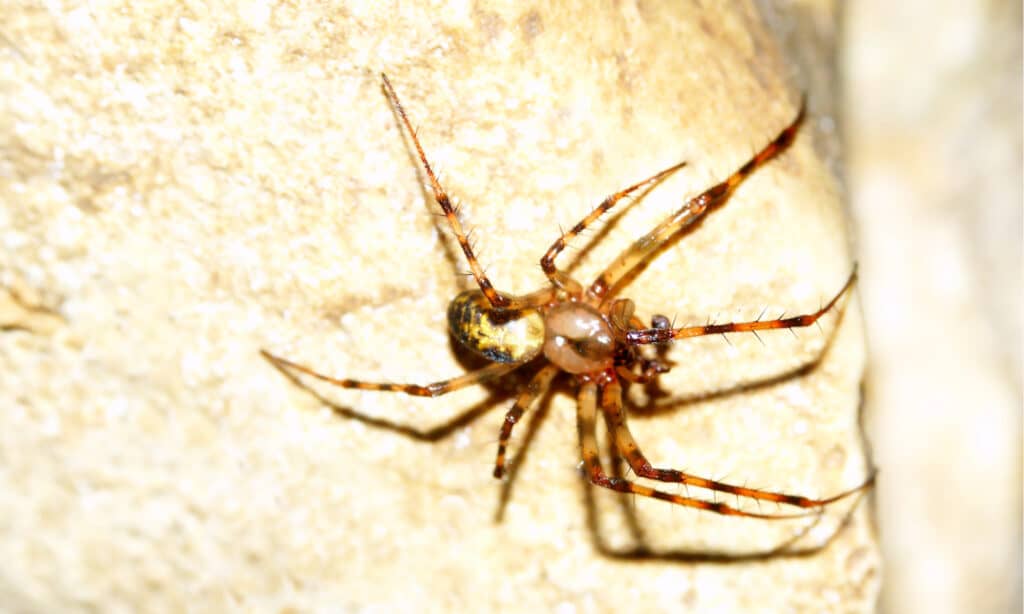
The cave orb-weaver spider builds its webs near the entrances of caves.
©Jason Patrick Ross/Shutterstock.com
The cave orb weaver, Meta menardi, is one of the more unusual spiders in Maine. It belongs to the law jawed orb-weaving spider family, Tetragnathidae, and is also known as the European cave spider or simply the cave spider.
Female cave orb weavers measure between 8 and 10 millimeters long, while males measure slightly smaller. Unlike other members of their family, cave orb weavers do not have long jaws, legs, or bodies. Their bodies typically appear dark brown. They feature light and dark brown bands on their legs and white and dark markings on their abdomens.
While most long-jawed orb weavers build horizontal webs, cave orb weavers construct vertical webs. They frequently build their webs along the ceilings of caves, old wells, or abandoned mines, hence their name. That said, they usually congregate near the entrances of caves where light is still present.
#8: Flower Crab Spider
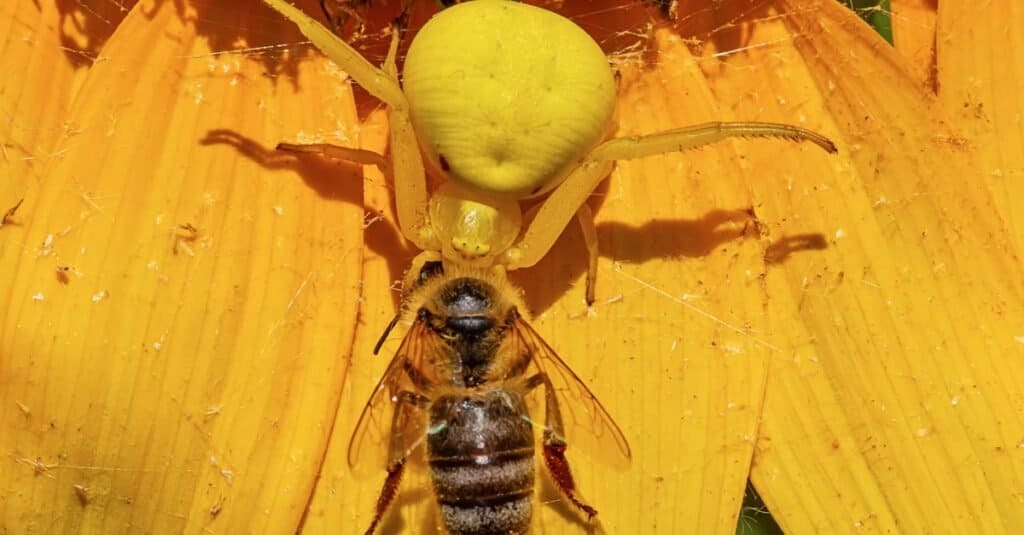
Flower crab spiders hunt for insects that come to feed on nectar or pollen.
©Nenad Nedomacki/Shutterstock.com
The flower crab spider (Misumena vatia) also goes by the name goldenrod crab spider. It gets this name from its habit of hunting in goldenrod flowers. It ranges throughout North America and Europe and is one of several crab spiders in Maine.
Female flower crab spiders measure up to 10 millimeters long, and males measure up to 5 millimeters. They typically appear yellow, white, or a mixture of these two colors. Flower crab spiders possess the ability to change between these colors depending on their diet and environment. Like crabs, they possess large front legs that they wield like pincers.
Flower crab spiders don’t spin webs to catch their prey. Instead, they wait on the petals or leaves of flowers and then ambush insects that come to feed on the nectar or pollen. They immobilize their prey with their venom and frequently take down insects much larger than themselves.
#7: Bronze Jumper

The bronze jumper actively hunts prey by jumping on unsuspecting insects.
©Pong Wira/Shutterstock.com
Eris militaris, or the bronze jumper, is a jumping spider in the family Salticidae. You can find these spiders in Maine as well as throughout much of the United States and Canada.
Female bronzer jumpers measure 6 to 8 millimeters, and males measure 4.7 to 6.7 millimeters in length. They typically appear light brown or bronze in color, which is where they get their name. Males usually look darker than females and feature white bands along the cephalothorax and abdomen. Meanwhile, females lack a white band along the cephalothorax and instead sport dorsal spots on their abdomens.
Like other jumping spiders, bronze jumpers do not use webs to catch their prey. On the contrary, they actively hunt prey using their keen eyesight and expert jumping ability. They tie a silk strand to the ground and then jump onto their prey before delivering a killing blow with their chelicerae.
#6: Long-Bodied Cellar Spider
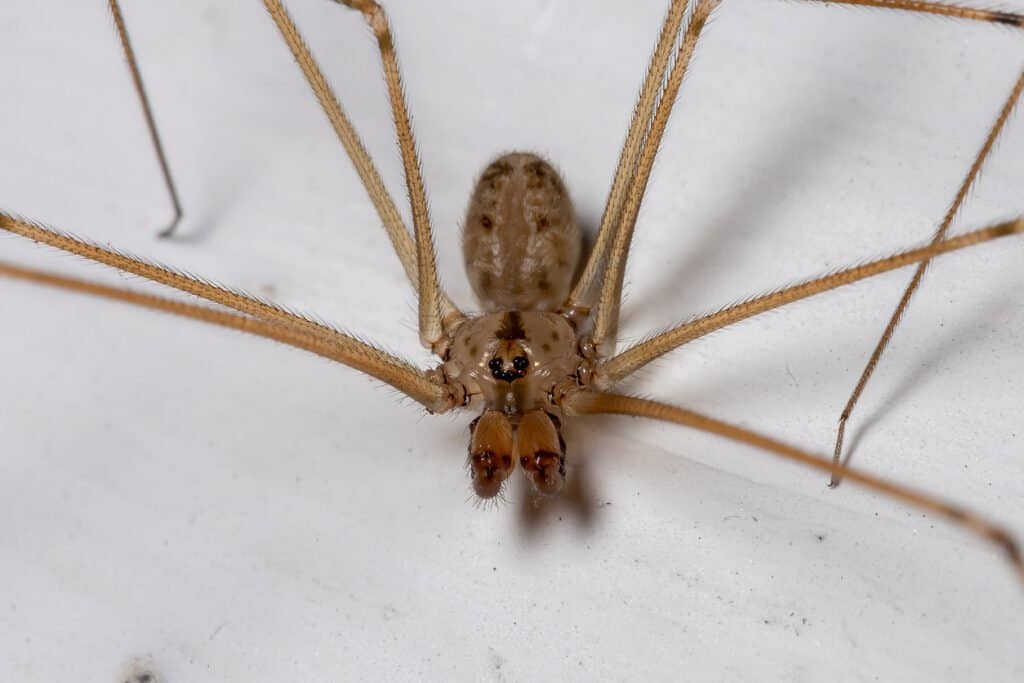
The cellar spider is also known as the daddy-long-legs.
©iStock.com/ViniSouza128
The long-bodied cellar spider, Pholcus phalangioides, is one of the most recognizable spiders in Maine. Also known as the daddy long-legs spider, you can find it on every continent except Antarctica. It prefers warmer, more humid climates and tends to shelter in human dwellings during colder months.
Females typically measure from 7 to 8 millimeters long, and males generally measure 6 millimeters long. Meanwhile, their legs can grow up to 50 millimeters long, which is where they get their name. They typically appear tan or yellow and feature grey markings on their carapace. These markings sometimes take the shape of a human skull, which is why they also sometimes go by the name skull spiders.
Long-bodied cellar spiders prefer dark, quiet areas. While they rarely act aggressively toward humans, they can bite. They don’t use webs to hunt and instead actively hunt other insects, invertebrates, and other spiders.
#5: Forest Wolf Spider
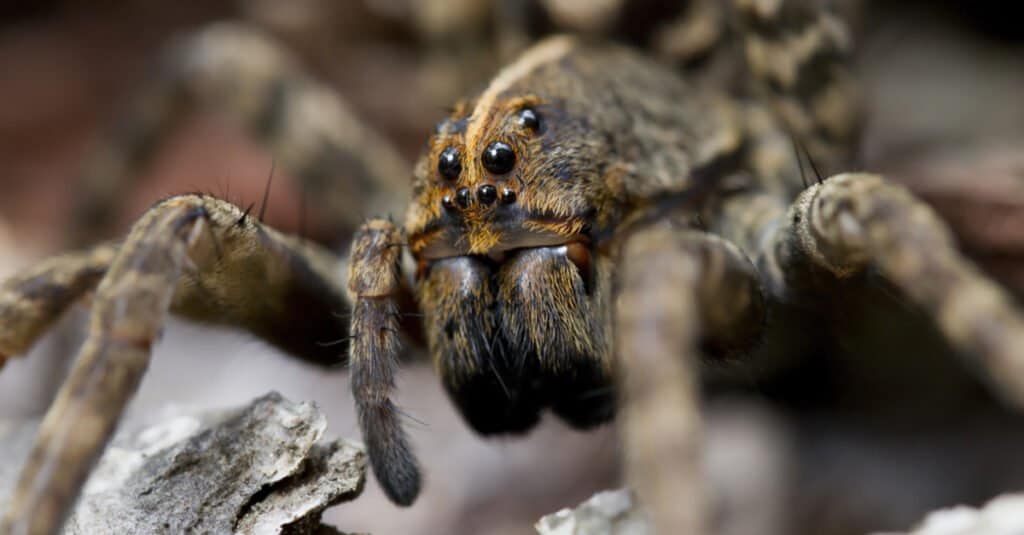
The forest wolf spider can reach nearly 50 millimeters long with its legs extended.
©Will E. Davis/Shutterstock.com
Hogna frondicola, or the forest wolf spider, is one of several wolf spiders in Maine. It ranges throughout most of the United States and Canada.
Adult forest wolf spiders measure nearly 50 millimeters long with their legs extended and females typically measure longer than males. They possess long, powerful legs that help them to chase and pin down prey. Their carapaces appear dark grey and feature a distinctive grey stripe down the center. Meanwhile, their abdomens and legs look light grey.
Like other wolf spiders, forest wolf spiders do not build webs to catch prey. Instead, these nocturnal hunters actively chase down insects and other spiders. When not hunting, they hide in underground burrows during the day. While their bite can be painful, they pose little threat to humans.
#4. Six-Spotted Fishing Spider
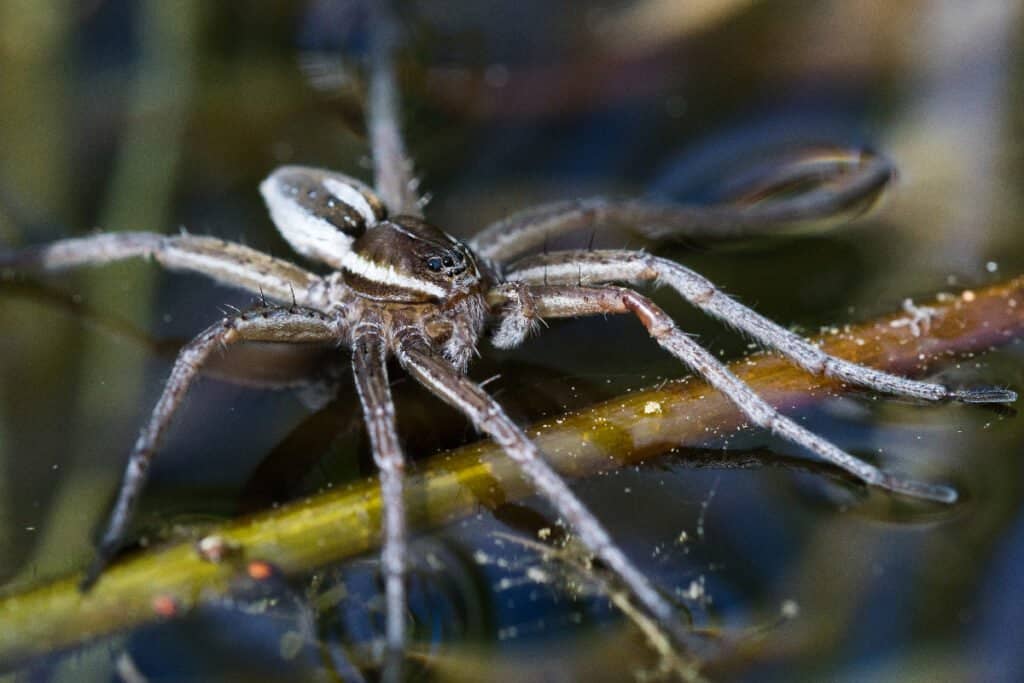
The six-spotted fishing spider can catch fish more than five times its own size.
©Jukka Jantunen/Shutterstock.com
The six-spotted fishing spider, Dolomedes triton, belongs to the nursery web spider family Pisauridae. You can find these spiders in Maine and throughout wetland habitats across North America. It is also called the dock spider since it often hangs around boat docks.
Female six-spotted fishing spiders measure 60 millimeters long with their legs extended and 15 to 20 millimeters long from head to tail. Meanwhile, males measure from 9 to 13 millimeters long. They appear predominantly light grey or brown and feature a white or cream-colored stripe down each side of the cephalothorax. Their abdomens feature six-dark spots on the dorsal side, which is where they get their name.
Six-spotted fishing spiders hunt for insects and small fish using their long legs as lures. They can also run across the surface of the water for short distances or dive under the water to catch prey.
#3. European Sheetweb Spider
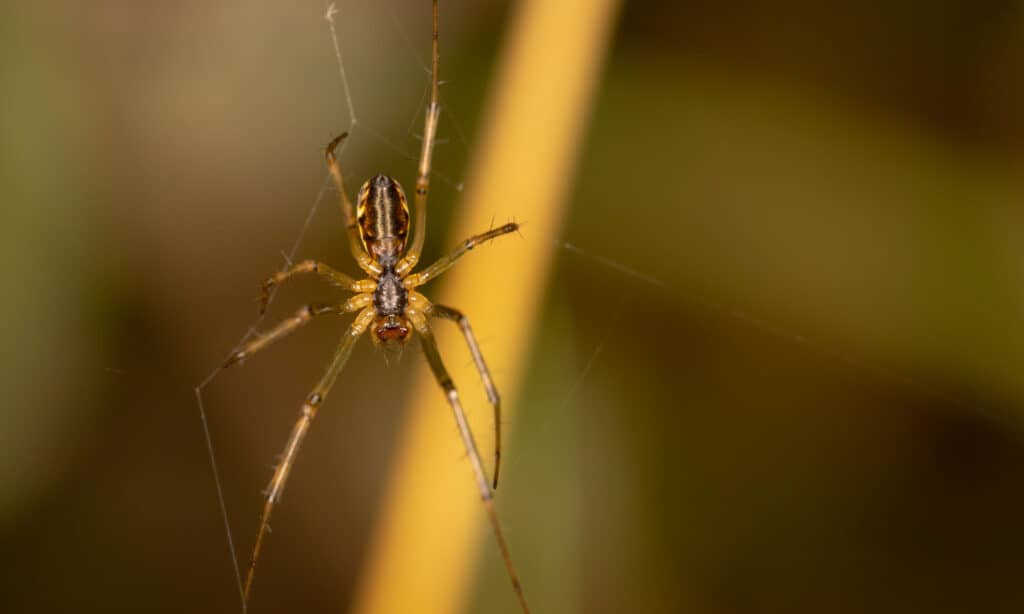
Except for Europe, you can only find the European sheetweb spider in Maine.
©Jordon Sharp/Shutterstock.com
Linyphia triangularis, or the European sheetweb spider, belongs to the sheetweaver spider family Linyphiidae. Outside of Europe, you can only find this spider in Maine, making it one of the rarer non-native spiders in the U.S.
Adult European sheetweb spiders grow up to 6 millimeters long. Their carapaces appear pale brown and feature dark markings along the edges and in the center. Meanwhile, their abdomens are mostly white, with brown markings along the sides. They have greyish-brown legs covered in long spines.
European sheetweb spiders build horizontal sheetwebs that they use to catch prey. They wait on the underside of their webs for insects to fall into tangle lines that they string above their sheetweb before swooping in for the kill. Unlike some weavers, they do not wrap their prey in silk. Due to their small size, they pose little threat to humans.
#2: Barn Orb Weaver Spider

The barn orb-weaver spider gets its name from its habit of building its web in barns.
©Ken Beard/Shutterstock.com
The barn orb-weaver spider, Araneus cavaticus, belongs to the orb-weaver family Araneidae. It also goes by the name the barn spider due to its habit of building webs in barns and other wooden structures. It ranges throughout the northeastern United States and Canada.
Females tend to measure 12 to 16 millimeters long, and males measure 6 to 10 millimeters long. They typically appear yellow or brown and feature dark stripes on their legs. Meanwhile, their lower bodies look black and sport white markings. Their bodies are quite hairy, and they have several small humps on their abdomens.
Like most other members of their family, barn orb-weaver spiders build flat, spiral-shaped webs made of sticky silk threads. They use their webs to capture prey, including flies, mosquitoes, and moths. While not medically significant, their bite may cause some redness and swelling.
#1. Northern Cupboard Spider
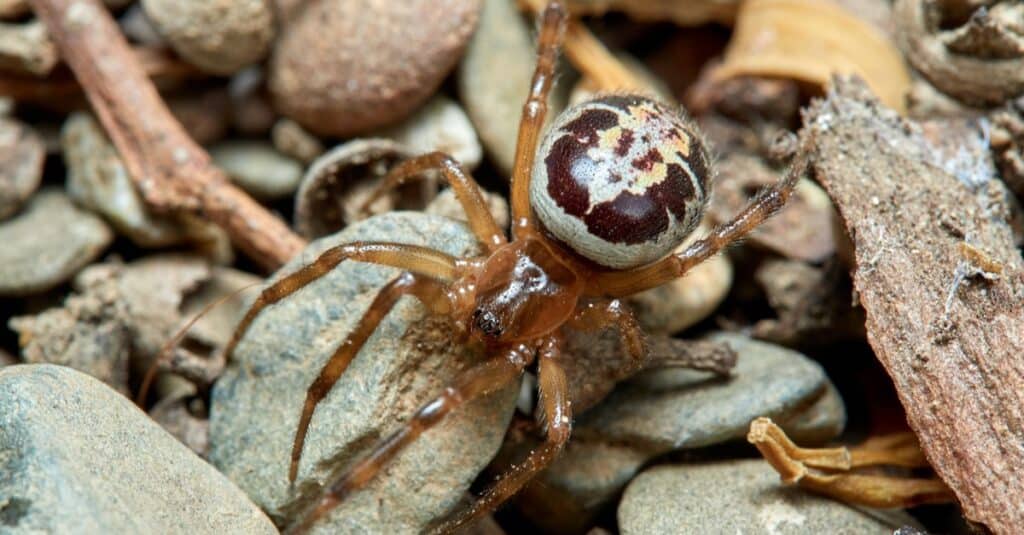
Since they often get confused for widow spiders, northern cupboard spiders also go by the name false widows.
©iStock.com/Macronatura.es
The northern cupboard spider, Steatoda borealis, also goes by the name the boreal combfoot spider. It belongs to the cobweb or combfoot family Theridiidae. You can find these spiders in Maine as well as throughout the northern United States and Canada.
Adult northern cupboard spiders measure about 7 millimeters long, with females measuring larger than males. They typically appear glossy dark brown or black and feature a T-shaped marking near the front of their bodies. Since they often get confused for widow spiders, they also go by the name false widows.
Like other members of their family, northern cupboard spiders build irregular webs that they use to capture their prey. Since they have poor eyesight, they sense vibrations to determine when prey stumble into their webs. Although their bite poses little threat to humans, it can cause mild pain, swelling, and redness.
Summary of 10 Spiders in Maine
Here’s a recap of 10 spiders found in the state of Maine that we took a close look at:
| Number | Spider | Scientific Name | Length |
|---|---|---|---|
| 1 | Northern Cupboard Spider | Steatoda borealis | 7 mm |
| 2 | Barn Orb Weaver Spider | Araneus cavaticus | Females: 12-16 mm; males 6-10 mm |
| 3 | European Sheetweb Spider | Linyphia triangularis | 6 mm |
| 4 | Six-Spotted Fishing Spider | Dolomedes triton | Females: 60 mm long with legs extended and 15-20 mm long from head to tail; males: 9-13 mm |
| 5 | Forest Wolf Spider | Hogna frondicola | 50 mm |
| 6 | Long-Bodied Cellar Spider | Pholcus phalangioides | Females: 7-8 mm; males: 6 mm. Legs can grow up to 50 mm long. |
| 7 | Bronze Jumper | Eris militaris | Females: 6-8 mm; males: 4.7-6.7 mm |
| 8 | Flower Crab Spider | Misumena vatia | Females: 10 mm; males: 5 mm |
| 9 | Cave Orb Weaver | Meta menardi | Females: 8-10 mm; males are slightly smaller |
| 10 | Common House Spider | Parasteatoda tepidariorum | Females: 5-6 mm; males: 3.8-4.7 mm |
The photo featured at the top of this post is © Danie Spreeth Photography/Shutterstock.com
Thank you for reading! Have some feedback for us? Contact the AZ Animals editorial team.






